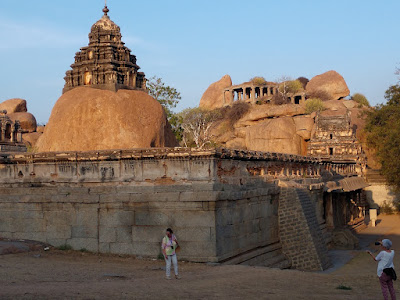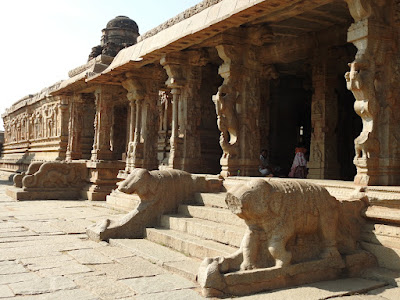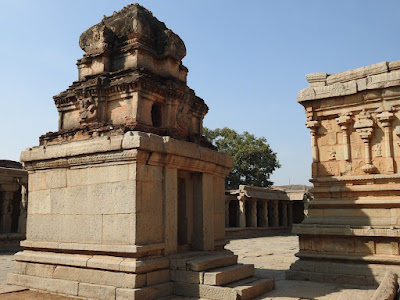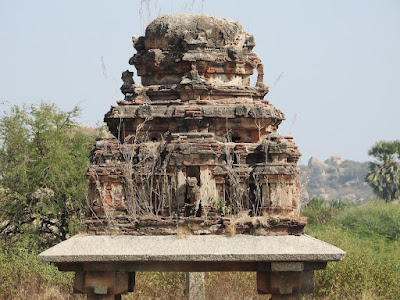..continued from a trip with brother, Hampi-4.
The second half of the tour commenced at Krishna Devastna & Bazaar. We must've spent more than hour admiring the stone work and, the remains of stucco art on the two towers of the temple i.e. the two Gopuras. In between we rested a bit too, we had to take breaks from the blazing sunlight. One relic of this temple which is unique is the donation chest made of granite blocks. The chest has two lids each with an opening for dropping cash or jewelry. Sheltered under a manatapa, the chest would be under heavy security during Vijayanagara times. Now, the monument is just an exhibit, seen by a fraction of tourists visiting Hampi.
Done with Krishna temple & market place, we head out towards Kamalapur and then to Malyavanta Gudda. The hillock is situated on Kamalapur-Kampli road, just 2.2 km from Kamalapur bus-stand. Though I'd visited Hampi half dozen times, this is only my second visit. The first time was Dec 2024 with Sridhar, it was midday when we came here.
This time we planned to come here late afternoon with a plan to see the Sun set. The short steep road going up the hill is okay for smaller passenger vehicles. Buses have to drop off people at the base and, they'll have to do the short trek.
Half way up the hill is this four-pillared manatapa. Besides it is a small flat ground. I guess this place was cart & cattle parking place during Vijayanagara times. We parked the car off the road and decided to check out the spot.
Another view of the Mantapa, and the southern Gopura of Malayavanta Raghunatha temple complex. Deepak wanted to launch his DJI Mini2 to shoot the wild hills and their rocky outcrops. We found a convenient spot on the side, it was partly shaded too. Yeah, sunlight was still blazing.
While Deepal got busy with his little flying machine, I took out my seldome used Canon and took a few shots. In the drier districts of Karnataka, especially on rocky hills one can see this silvery barked tree called Twanpani Mara. A fully grown tree seldom exceeds an height of 20 feet. It's wood is soft and decays fast. At the most it could be used at fuel. Apart from it's silvery bark, the other attraction of this tree is it's seeds. The seeds have two wings. When the seed frees itself, it spins like a propeller and floats down gently. Hence the tree is called propeller tree. It's botanical name is Gyrocarpus americanus.
During the winter months, the tree is bare except for bunches of seeds. Once the green wings dry and turn brownish-grey they get separated. Being situated on elevated & windy spots the seeds get spread out naturally. One can rarely this tree on flat open grounds. While on this topic, you might want to read an older blogpost on spinning seeds.
Here's a collage of a few shots.. a jagged surface of a sedimentary rock. After-life beauty of a wild plant. A weathered twig. Lastly, a bottle bap embedded in some kind of binding matter, probably mortar.
Bird's eyeview of Malyavanta Gudda. The temple complex can be spotted on the hill. Yes, this picture was captured by Deepak's bird.
Done with flying the bird and shooting random objects we pack up and head towards the temple.
This is the parking space, good enough for half a dozen cars and bikes. In plan, this is the eastern gate, technically the main gate however, the southern gate is grander since it faces the approach road. From here instead of entering the temple through the Gopura, you take the narrow path straight ahead, it leads to a staircase which in turn takes you to a group of manatapas atop the rock formation. That spot gives an interesting view of the temple and surrounding hills. Sridhar and I had been there however, this time I didn't suggest that.
This being a east-facing temple, it was pretty dim at this time of the day. The complex consist of three temples, one pillared hall, plenty of open space and a few large trees. The trees makes it even more dim. So we just looked around and rested. The open ground between Raghunatha Devastana and Kalyana Mantapa are two trees, Neem and Frangipani. Together they create a great ambiance, a great place to rest. At one of the corners lies a sculpture of a woman and fish. No ides what it depicts. Perhaps it's a kind of memorial stone. While people moved around on the ground, a red-faced monkey was picking something from Neem branches.. maybe ripe fruits.
Here's a collage of Frangipani, one of my favorite flowers. It's fragrance is mild and pleasant. Frangipani thrives where there's granite. You can find Frangipanis close to the summits of Savandurga and Chitradurga.
While one lone monkey was peacefully browsing Neem branches, a bunch of them were monkeying. Those four rowdies have piled up on that seemingly timid fellow. Deepak captured this amusing invaluable scene.
We got up and slowly made our way to the rear gate which leads to the sunset drama stage. There was a busload of French tourists thoroughly enjoying their tour of Hampi. A good number of them were elderly, trying to make the best of their time. See this picture.. the lower part is in shadow and the upper part is lit up in light quickly turning golden. Note the main temple's Shikhara, it's part natural rock and part brick-mortar construction. Earlier I had mentioned about a mantapa atop the rock formation. Now that's seen. That's a seldom visited spot.
Here we have the Shikharas of the main temple on the right, and the subsiadary temple on the left. The perimeter wall has cast its shadow and a narrow band of light has escaped through the narrow passage.
That's the Kalyana Mantapa and the southern Gopura. In the foreground is an incomplete sculpture of a lathe-turned wheel. In fact, if you look to the right, there's another one.
As we stepped out of the passage, Bala Hanuman leapt in front of us! This kid knew how to surprise people, and pose for pictures.
We learnt that this little Hanuman is trying to raise funds for medical treatment of a family member. I think the French tourists donated generously.
The southern Gopura seen from the elevated spot behind the complex. The design of ancient temple towers is much more than what meets the eyes. There's a rocket science connection to these structures.
Outside the walls of Raghunatha temple complex is a small shrine dedicated to Shiva. It's like a cave shrine, one has to bend low inside. That shrine is below this boulder and exactly below it's Shikhara is the Shiva Linga. Suryadeva has entered the stage and the audience was gathering. I realized that quite a crowd had turned up suddenly. Well, most of them wanted front row seats and we opted for the last row.
We didn't capture the dramatic moments as such but here's a good one by Deepak.
That's Anjanadri Betta, believed to be the birthplace of Hanuman. It's quite a landmark, hard to miss it while photographing in and around Hampi. We could see lights turning on out there. Off late the hill has gained popularity and people throng to it almost round the clock. We too had planned to go there in the morning.
We called it a day and headed back to Mayura Bhuvaneshwari. Over drinks and snacks we chatted past happenings.. sour, sweet and bitter memories.
Our trip is coming to its end and I'll wrap it up in the final post- a trip with brother, Anjanadri and Onake Kindi.
.........






































































